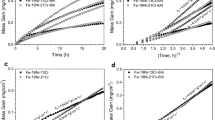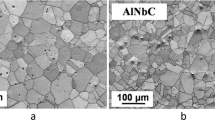Abstract
The corrosion behavior of eight Fe-Nb-Al ternary alloys was studied over the temperature range 700–980°C in H2/H2O/H2S atmospheres. The corrosion kinetics followed the parabolic rate law for all alloys at all temperatures. The corrosion rates were reduced with increasing Nb content for Fe-x Nb -3Al alloys, the most pronounced reduction occurred as the Nb content increased from 30 to 40 wt.%. The corrosion rate of Fe-30Nb decreased by six orders of magnitude at 700°C and by five orders of magnitude at 800°C or above by the addition of 10 wt.% aluminum. The scales formed on low-Al alloys (≤3 wt.% Al) were duplex, consisting of an outer layer of iron sulfide (with Al dissolved near the outer-/inner-layer interface) and an inner complex layer of FexNb2S4(FeNb2S4 or FeNb3S6), FeS, Nb3S4 (only detected for Nb contents of 30 wt.% or higher) and uncorroded Fe2Nb. No oxides were detected on the low-Al alloys after corrosion at any temperature. Platinum markers were found to be located at the interface between the inner and outer scales for the low-Al alloys, suggesting that the outer scale grew by the outward transport of cations (Fe and Al) and the inner scale grew by the inward transport of sulfur. The scales formed on high-Al alloys (≥5 wt.% Al) were complex, consisting primarily of Nb3S4, Al2O3 and (Fe, Al)xNb2S4, and minor amounts of (Fe, Al)S and uncorroded intermetallics (FeAl and Fe2Nb). The formation of Nb3S4 and Al2O3 blocked the transport of iron through the inner scale, resulting in the significant reduction of the corrosion rates.
Similar content being viewed by others
References
F. Gesmundo and F. J. Viani,J. Electrochem. Soc. 128, 470 (1981).
G. C. Wood and F. H. Stott,Mater. Sci. Technol. 3, 519 (1987).
S. Mrowec and K. Przybylski,High Temp. Mater. Proc. 6, 1 (1984).
S. Mrowec and K. Przybylski,Oxid. Met. 23, 107 (1985).
W. Kai, D. L. Douglass, and F. Gesmundo,Oxid. Met. 37, 189 (1992).
Y. He, D. L. Douglass, and F. Gesmundo,Oxid. Met. 37, 217 (1992).
C. C. Shing, D. L. Douglass, and F. Gesmundo,Oxid. Met. 37, 167 (1992).
W. Kai, D. L. Douglass, and F. Gesmundo,Oxid. Met. 37, 389 (1992).
Y. He, D. L. Douglass, and F. Gesmundo,Oxid. Met. 37, 413 (1992).
C. C. Shing, D. L. Douglass, and F. Gesmundo,Oxid. Met. 37, 441 (1992).
W. Kai and D. L. Douglass (to be published).
G. Wang, D. L. Douglass, and F. Gesmundo,Oxid. Met. 35, 349 (1991).
R. V. Carter, D. L. Douglass, and F. Gesmundo,Oxid. Met. 31, 341 (1989).
A. F. J. Ruysink, F. Kadijk, A. J. Wagner, and F. Jellinek,Acta Cryst. B24, 1614 (1968).
G. Wang, B. Gleeson, and D. L. Douglass,Oxid. Met. 31, 415 (1989).
Author information
Authors and Affiliations
Rights and permissions
About this article
Cite this article
Kai, W., Douglass, D.L. The corrosion behavior of Fe-Nb-Al alloys in H2/H2O/H2S atmospheres. Oxid Met 39, 317–352 (1993). https://doi.org/10.1007/BF00664660
Received:
Revised:
Issue Date:
DOI: https://doi.org/10.1007/BF00664660




